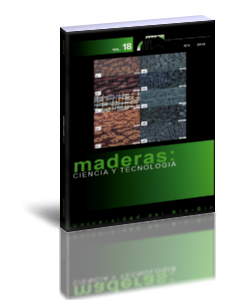Studies on effect of coat thickness on the moisture uptake by a hardwood substrate
Keywords:
Dalbergia sissoo, coating thickness, moisture sorption, MEE, polyurethane, shellac, water vapour transmission.Abstract
The moisture sorption behaviour of three coating thicknesses of shellac and polyurethane films on Dalbergia sissoo substrate is studied in this paper. The thin films of either coat failed to reduce the water vapour transmission significantly. However, the thick coats were able to reduce this rate illustrating the importance film thickness of coating used on surfaces of wood products. The increment in Moisture Content over the conditioned MC showed a clear film thickness effect in the case of PU with the increments reducing with increasing thickness. The Moisture Exclusion Effectiveness of PU coating showed better values than shellac coating with both the finishes showing a thickness effect. More importantly, the study illustrated the effect of coating thickness even when the differences are
small.
Downloads
References
Bedane, A.H.; Huang, Q.; Xiao, H.; Eić, M. 2012. Mass transfer of water vapor, carbon dioxide and oxygen on modified cellulose fiber-based materials. Nordic Pulp and Paper Research Journal 27(2):409-417.
Borgin, K. 1961. The effect of water repellents on the dimensional stability of wood. Norsk Skogindustri 11:507-521.
Boyd, J.M.; Daalen, D.V. 1976. Water vapour barrier coatings for Poly Urethane foams. Report No. HDL-76-14, US Army Materiel Development & Readiness Command, Alexandria, VA 22333, 16p.
Carter, N. 2012. Scavenge moisture and cut pinholes in a trice. European Coatings Journal 6:18-21.
Cassens, D. L.; Feist, W.C. 1986. Finishing Wood Exteriors: Selection, Application, and Maintenance. Research Paper of U.S. Department of Agriculture, Forest Service, Agriculture Handbook No. 647, Forest Products Laboratory Madison, WI. 60 p
Engelund, E.T.; Thygesen, L.G.; Svensson, S.; Hill, C.A.S. 2013. A critical discussion of the physics of wood–water interactions. Wood Sci Technol 47:141-161.
Farag, Y.; Leopold, C.S. 2011. Investigation of drug release from pellets coated with different shellac types. Drug Development and Industrial Pharmacy 37(2):193-200.
Feist, W.C.; Little, J.K.; Wennesheimer, J.M. 1985. The Moisture Excluding Effectiveness of Finishes on Wood Surfaces. Res. Pap. FPL 462 Madison, WI: U.S. Department of Agriculture, Forest Service, Forest Products Laboratory; 38p.
Fernández, I.; Fernández, M. Á.; Rodríguez, K.; Baño, V.; Dieste, A. 2013. The effect of wood species on the anti-skid resistance of coatings. Maderas-Cienc Tecnol 15(1):65-72.
Ghosh, M.; Gupta, S.; Kishan Kumar, V.S. 2015. Studies on the loss of gloss of shellacand Polyu rethane finishes exposed to UV. Maderas-Cienc Tecnol 17(1):39-44.
Hagenmaier, R.D.; Shaw, P.E. 1991. Permeability of Shellac Coatings to Gases and Water Vapor. J Agric Food Chem 39:825-829.
Kishan Kumar, V.S.; Upadhyay, K.K.; Gupta, S. 2009. Studies on moisture resistance of a traditional and a commercial finish on mango wood at elevated temperature and high relative humidity. J Indian Academy of Wood Sciences 6 (1&2):36-44.
Kollmann, F.P.; Cote, W.F. 1984. Solid wood, Principles of wood science and technology. Reprint Springer-Verlag, Tokyo, Vol.1: 180p.
Lei, S.; Qingfeng, S.; Jiang, D. 2011. Primary study on the anatomical construction and physicalmechanical-properties of introduced Dalbergia sisoo. Advanced MaterialsResearch 179-180:1446-1452.
Malkov, S. 2002. Studies on liquid penetration into softwood chips - experiments, models and applications. Helsinki University of Technology, Laboratory of Pulping Technology Reports, Series A29, Department of Forest Products Technology, p 24-26.
Meijer, M. D.; Militz, H. 2001. Moisture transport in coated wood. Part 2: Influence of coating type, film thickness, wood species, temperature and moisture gradient on kinetics of sorption and dimensional change. European Journal of Wood and Wood Products 58 (6):467-475.
Michalec, J.; Niklasova, S. 2006. Water uptake of hardwoods. Thesis work no. TD083/2006, Dept. of forest and wood technology, Vaxjo University, School of Technology and design, TD. 10p.
Niederer, B. 2007. Moisture Exclusion Effectiveness - Accelerated testing in our environmental huts. Epoxy works, No. 25:1-2.
Pandey C.N.; Jain, V.K. 1992. Wood seasoning Technology. Publication No. ICFRE 20, Indian Council of Forestry Research and Education, Dehradun, INDIA, pp 144.
PFCD-MVT-3/91.1991. Moisture vapour transmission. Polyurethane Foam Contractors Division, The Society of the Plastic Industry, Inc. Washington DC, pp 11.
Poaty, B.; Riedl, B.; Blanchet, P.; Blanchard, V.; Stafford, L. 2013. Improved water repellency of black spruce wood surfaces after treatment in carbon tetrafluoride plasmas. Wood Sci Technol 47:411-422.
Quirk, J.T. 1983. Data for a computer-assisted wood identification system I. Commercial legumes of tropical Asia and Australia. IAWA Bulletin 4(2-3):118-130.
Rajput, S.D.; Mahulikar, P.P.; Gite, V.V. 2014. Biobased dimer fatty acid containing two pack polyurethane for wood finished coatings. Progress in OrganicCoatings 77:38-46.
Rehman, M.A.; Singh, G. 1969. Wood water relationship: Equilibrium moisture content of Indian woods. J Timber Development Association of India 15(1):30-34.
Sattar, M.A.; Bhattacharjee, D.K.; Kabir, M.F. 1999. Physical and mechanical Properties and uses of timbers of Bangladesh. Bangladesh Forest Research Institute, Chittagong, pp 57.
Schniewind, A.P.; Arganbright, D.G. 1984. Coatings and Their Effect on Dimensional Stability of Wood. Waac Newsletter 6(2):2-5.
Spence, K.L.; Venditti, R.A.; Rojas, O.J.; Pawlak, J.J.; Hubbe, M.A. 2011. Water vapour barrier properties of coated and filled microfibrillated cellulose composite films. BioResources 6(4):4370-4388.
The, D.P.; Debeaufort, F.; Luu, D.; Voilley, A. 2008. Moisture Barrier, Wetting and Mechanical Properties of Shellac/Agar or Shellac/Cassava Starch Bilayer Bio-Membrane for Food Applications. J Memb Sci 325:277-283.
Thygesen, L.G.; Engelund, E.T.; Hoffmeyer, P. 2010. Water sorption in wood and modified wood at high values of relative humidity-Part 1: results for untreated, acetylated, and furfurylated Norway spruce. Holzforschung 64:315-323.
Wheeler, E.A. 1983. Wood structure and properties: Finishing eastern hardwoods. Forest Research Society Products, Madison, 5-14.

































